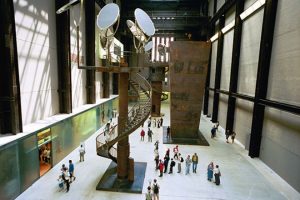What is fine art? What is pop art? What is postmodernism? Minimalism? Conceptualism? These are all questions that come to mind (at least mine) and have been answered well enough after reading the chapter entitled “Art” from the book “Critical Terms for Media Studies” by W.J.T. Mitchell and Mark B.N.Hansen.
The chapter is really a great introduction (fast track style) to getting a quick handle on what is art, where it’s come from, and how many different types of art have been conceived throughout the ages.
One of the themes that I saw was change. Art seems to have metamorphosed drastically throughout the ages, centuries. The chapter starts painting a picture of art being at one with itself – a simplified period where art is just art. That is, art does not need to be categorized based on whether it’s for aesthetic reasons, practical functions, toolsets used, political, cultural, or religious foci.
Joanna Drucker, the author of this chapter, talks about how the Renaissance helped create the artist persona as rebel, being “at odds with culture and society” whereas the fifteenth century showed the first signs of turbulence with art as the technology of the printing press seemed to erode art’s uniqueness with the introduction of mass production. The sudden changes from the twentieth century however form the emphasis of this chapter with the industrial revolution, mass media, and business all becoming threats to this simplified view of art as one and not a collective of disparate facets, sometimes cannibalizing one another.
For example, Pablo Picasso used mass-produced printed materials in his works – introducing a recursive message within the medium. Art it seemed, was going through a tumultuous adolescent time period.
However, the transmogrification that I found most interesting was Joanna Drucker’s mention of the Fluxus movement in the 1960s and 1970s where art disembodied itself from material form. Was this because of the widespread availability of new and continually changing technology? If so, perhaps this movement is a great commentary and reflection on culture and how our technology has disembodied us from the natural world.

Figure 1
This is one of the messages that Louise Bourgeois had in her “I Do, Undo, Redo” installation (see figure 1). The exhibit offers three 30 foot steel towers that are surrounded with spiral staircases with the top having a platform for visitors to view from but which are overshadowed with large circular mirrors. In “I Do, Undo, Redo”, visitors will feel isolated, anxiety as they climb the spiral staircase, and feel self-conscious as the mirrors reflect them and see others’ gaze upon themselves.
But while there is disembodiment, the diversity of what art is today is exciting.
Add yours Comments – 1
Great summary Arron — hopefully it whets your appetite to dig deeper. The notion of the artist persona as rebel, being “at odds with culture and society”, as you say, is especially resonant with some of the conversations we have been having in the seminar–why are artists (and in our case, electronic artists) so well positioned to use their practice to raise questions about society and the status quo?